Valentine’s Day isn’t my thing. As I said last year I’m not into hearts and super feminine girly stuff, and I don’t do red or pink. (Seriously, you won’t find a single item of pink clothing in my wardrobe, and the one and only pink thing I do own is a pink and white plate that I bought for styling a Valentine’s Day dish once. So yeah, not really my speed.) Now don’t get me wrong, I can be a total romantic under the right circumstances, I just don’t see the romance in a commercialized holiday that was basically created by the greeting card and chocolate industries to sell more product. Anyone who’s ever worked in restaurants can tell you that we dread Valentine’s Day. It’s the second busiest day of the year, it’s all tables for two – many of whom are getting a wee bit too cozy and making the others around them uncomfortable – and everyone wants to feel like they’re enjoying a special night out, even though there’s nothing special about sitting in a room full of strangers all eating the same overpriced set menu. Surprise me with a home cooked meal or a bunch of wildflowers on a random Tuesday. That’s romantic. A mediocre dinner in a crowded, staged restaurant on February 14th? No thanks. [end rant]
I get it, some folks just want to get out of the house and maybe take a night off from the kids, and I completely respect that. But if you’re like me you’d probably rather stay home, make a simple and elegant meal, and enjoy a quiet evening in the company of someone you like to be around…and PS it absolutely doesn’t have to be complicated or angst-inducing. Case in point: the recipe I’m sharing with you today, which sounds fancy and looks impressive but is deceptively easy to pull together. It’s ideal for a special evening when you want to keep things relaxed and stress-free. And because I’m not a total grinch (I know, wrong holiday, but whatever), I’ve even made sure to include a red element on the plate thanks to those beautiful jewel-toned oranges that you’re going to turn into a syrup. If you want to get crazy you can also use pink, red, or purple carrots, but I don’t recommend using dark red beets as they’ll just bleed into the entire package and stain everything the same color. Monochromatic food usually isn’t all that exciting to look at after a bite or two.
The parchment packet method is a classic, simple, and efficient way to cook seafood. You layer your ingredients on a sheet of parchment paper, seal it up, slide it into the oven, and let it cook to perfection. There’s no need to contend with spattering oil, or finicky fillets that stick to the pan and break apart, and clean-up is a breeze. (As far as I know, no one on Earth thinks scouring a greasy stove or scrubbing a mountain of dishes is romantic.) Another great thing about this dish? Once the sauce is made, the other components cook together in one shot so you’re not dealing with multiple pans or trying to juggle various cook times, and when all is said and done you have a delicious, balanced meal tied up in a lovely little package. When you’re ready to begin your evening just assemble the parcels, enjoy your favorite aperitif or a glass of wine or bubbly while your meal is baking in the oven, then dig in and enjoy! Oh, and on the topic of imbibements, if you’d like to serve wine with this dish I recommend a dry rosé from the Pacific Northwest, a New Zealand Sauvignon Blanc, or a White Bordeaux.
Fish in parchment is lovely enough on its own, but the spicy Blood Orange Gastrique for this dish makes it a bit more special. A gastrique is a type of sauce made by reducing honey or sugar with vinegar and flavorings until you’re left with a sweet and sour syrup. I use honey for the sweet element here since I like the way its floral notes pair with the orange, and the sauce is spiked with fruity, spicy Aleppo pepper flakes for a touch of heat. A little gastrique goes a long way, so a drizzle over the dish just before serving will add tons of flavor and an elegant finishing touch. The recipe makes more gastrique than you need here, but it keeps well in a glass jar in the refrigerator for weeks so you can enjoy it with other fish, vegetable, and poultry dishes long after Valentine’s Day. You also have the option of making the gastrique ahead of time if you want to keep your kitchen time to a minimum on the day you’re planning to serve this dish.
See? As promised you’ll have something red on the plate. I always keep my word! Now let’s get started on this stunning sauce…
Start with the honey in a non-reactive saucepan over medium-low heat. Be sure to use a pan that allows you to see the color change as the honey cooks (no dark grey or black, please).
The honey will bubble and foam up, so watch the pan as it cooks and pull it off for a few seconds here and there and swirl gently to allow the foam to subside.
Notice the major difference in color from the first photo? You can also see the foam as it settles down. Once it darkens to a deep amber like this, you can add the vinegar.
While the honey and vinegar are simmering, zest two of the oranges and cut them in half.
Juice the first four halves, which should give you enough for the gastrique – you need one third cup of juice. If you’re short you can juice another half, but two standard (4-ounce) oranges will yield enough. Once the honey and vinegar have reduced by half, add the zest, juice, and Aleppo pepper flakes and let it simmer until it’s just thick enough to cling to the back of a spoon.
This is what you want – it’s *just* thick enough to cling to the spoon without all running right off. It’ll thicken more as it cools so you end up with a sauce that has a slightly thicker consistency than maple syrup. Now pass it through a fine mesh strainer to remove all the zest and pepper flakes, stir in the salt, and keep it in a sealed jar until you’re ready to serve it. (Pop it into the fridge if you’ve made it in advance of serving day.)
The ingredient prep for the parcels is pretty simple, but I’ll walk you through the process step by step to show you how everything comes together.
Mix up your marinade in a medium bowl and set it off to the side. Cut the fennel into thin slices lengthwise, running from the stalk end to the root end. Make sure they’re no thicker than about ⅛ inch so they cook through. Add those slices to the bowl, then slice the leek and add that as well.
I like to give it a quick toss at this point, then move on to the beets.
Scrub the beets well to remove any grit, then peel them. If possible you want to use baby beets that are about the size of golf balls.
Cut each beet in half from top to stem, then cut the halves into thin half-moons. You’re aiming for ¼-inch thickness to make sure the beets cook all the way through. If you can only find large beets, you want to start with a total weight of about 7 ounces before trimming and peeling, then cut them down into quarters before slicing.
Add the beets to the other vegetables. Cut a blood orange in half, cut one of the halves into thin slices – set those aside – and squeeze the juice from the other half over the vegetables. Give it all one last toss and let it hang out while you set up your assembly.
Assuming you’re planning to bake and serve the parcels now, go preheat the oven. Make sure the oven rack is in the middle or lower-middle position if you have an upper heating element because you don’t want the paper to catch fire! If you’re doing this prep in advance, keep all the elements in the fridge separately – don’t forget to have your greens ready as well – then assemble them just before baking. If they sit too long the parchment can get soggy from moisture and you risk having it tear and leak.
To assemble the parcels, stack two sheets of parchment on your work surface and brush the center of the top sheet with a very light coat of olive oil. I like to brush it on in a square, making sure to leave at least 2 inches clean on all sides. Use that border as your guide when you’re stacking the ingredients – you need sufficient free space to fold and seal the paper.
Arrange half the greens in the center, and top with one or two orange slices depending on how big they are.
Pile half of the marinated vegetable mixture on the greens, and spread it all out into an even layer.
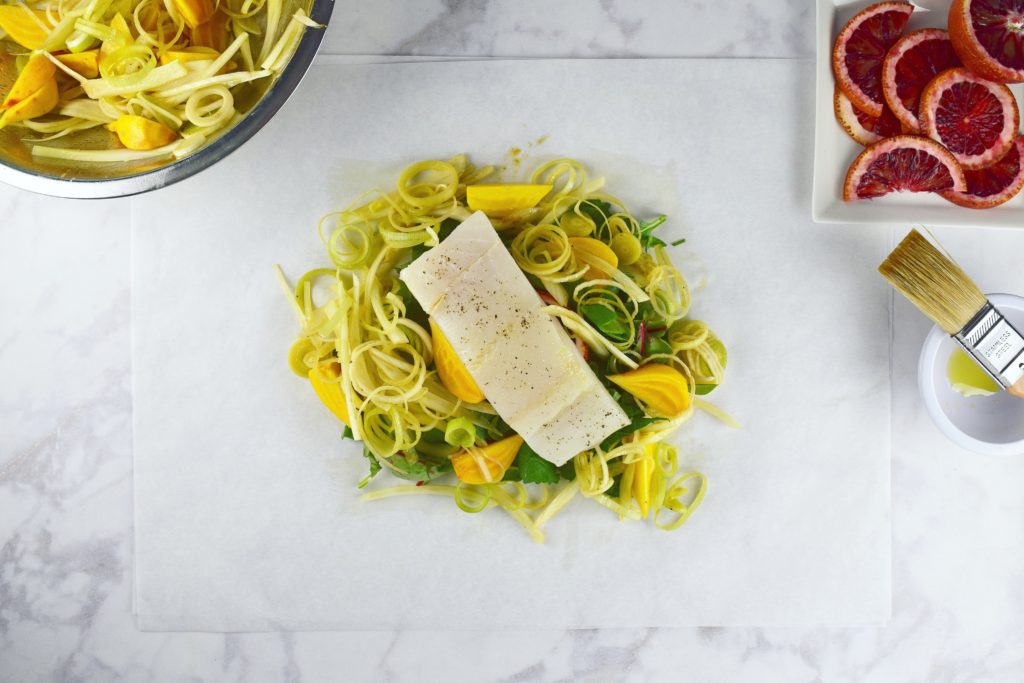 Pat your fish dry (I used halibut), brush with a light coat of olive oil, and season generously with salt and pepper. Lay one fillet in the center of the vegetables.
Pat your fish dry (I used halibut), brush with a light coat of olive oil, and season generously with salt and pepper. Lay one fillet in the center of the vegetables.
Arrange one or two orange slices in the center of the fillet.
Stack two carrot halves crosswise on top, and add one sprig of thyme. Slide this sheet off to the side and repeat all those steps with the second parcel. When you’re done you should have some marinade left in the bottom of the vegetable bowl. Sprinkle it over the two servings, dividing evenly.
Doesn’t that look fabulous already? And it’s not even cooked yet!
Now for the fun part: the wrapping. Remember that you’ll need butcher’s twine (or some other type of string that’s safe to use in the oven). The key here is to start with the sides of paper that have less free space, so in my photo it’s the top and bottom. Pull them up and over the ingredients until they meet in the middle, then pinch them together as you gather in the left and right sides, so all the edges of the paper are bunched up over the center. Gently twist the whole bunch just to tighten it a bit and give yourself a defined “neck” around which to tie the twine. Yeah, I know that sounds kind of violent, sorry 😬 Now loop the twine around that twisted neck of paper, tie it tight, and knot it to make sure it doesn’t pop open during baking. Repeat the process with the second parcel.
See? Cute little packages wrapped and ready for baking. Inspect them to ensure that the ingredients are completely enclosed and there are no gaps through which steam can escape or moisture can leak. The oven should be hot by now, so place the parcels on a sheet pan and slide it into the oven. Set a timer for 15 minutes and go relax while the magic happens! When the timer goes off, use a sturdy flat spatula to transfer the parcels to dinner plates.
I love the wow factor of cutting open the parcels at the table. Use a pair of kitchen shears or scissors, and snip the whole top off below the twine. Please keep your face away from the top as you do this because steam will escape. There’s nothing romantic about spending your Valentine’s evening in the ER with steam burns on your face.
Oh hey there, sexy, steamy dish. The fish is juicy and meltingly tender, the vegetables are *just* cooked through but still have their shape and some texture, and it’s all seasoned deliciously from mingling together in that little package. At this point I usually trim away the excess paper around the edges so it doesn’t hang over the rim of the plate. Then garnish with minced chives and fennel fronds, drizzle with some of that glorious gastrique, and enjoy! Happy Valentine’s Day.
- For Gastrique:
- 80g (¼ cup) honey¹
- 150ml (½ cup + 2 Tbsp) white wine vinegar
- Zest of 2 blood oranges
- 85 ml (⅓ cup) blood orange juice² (from 2 oranges)
- ½ tsp Aleppo pepper flakes
- ⅛ tsp salt
- For Parcels:
- 25 ml (1 Tbsp + 2 tsp) extra virgin olive oil, plus more for brushing
- 10 ml (2 tsp) gluten-free worcestershire sauce
- 1 tsp finely grated ginger
- 1 tsp minced or finely grated garlic
- ¼ tsp Aleppo pepper flakes
- Kosher salt
- ½ small fennel bulb, core removed, fronds reserved
- One leek (8 oz), white and light green parts only, washed well
- 4 small (golf ball-size) gold or pink beets, washed and peeled
- 1 blood orange or Cara Cara
- 3 oz beet tops or other greens, washed & dried
- Two thick³ 6-ounce fillets of firm white fish such as halibut or cod
- 2 small young carrots⁴, peeled and sliced in half lengthwise
- 2 sprigs thyme
- 1 tsp finely chopped chives
- Chopped fennel fronds
- Equipment Needed:
- 2 sheets 12x18 parchment paper
- Butcher’s twine
- Make Gastrique: In a small non-reactive saucepan, heat honey over medium-low heat until the color darkens to a deep amber, about five minutes. (The honey will foam quite a bit, so stick close to the stove and swirl the pan or remove it from the heat for a few seconds if it's really bubbling up). Add vinegar, increase heat to medium, and cook at a bare simmer until reduced by about half, about five more minutes. Add orange zest, orange juice, and Aleppo pepper, and simmer until reduced to a thin syrup that coats the back of a spoon, 8-10 minutes (it will thicken further as it cools, and eventually reach a consistency that's slightly thicker than maple syrup). Remove from heat, pass through a fine mesh strainer into a glass jar, add salt, and shake or swirl to dissolve. Gastrique will keep in the refrigerator for several weeks.
- Prepare remaining ingredients: In a medium bowl whisk together 25 ml (1 tablespoon + 2 teaspoons) of the olive oil, the worcestershire, ginger, garlic, Aleppo pepper, and a pinch of salt. Cut fennel into thin slices, and add to bowl with marinade. Slice leek into thin rings and add to bowl with fennel. Cut beets into thin half moons (no thicker than ¼ inch) and add to bowl as well. Toss vegetables to coat with marinade and set aside.
- Cut orange in half, and cut one half into very thin slices (no thicker than ⅛ inch). Squeeze juice from remaining half into bowl with vegetables, tossing to distribute.
- Preheat oven to 425°F.
- Assemble packets: Stack two 12x18 sheets of parchment on work surface. Spread or brush a very light and even coating of olive oil in the center of the top sheet. Place half the greens in the middle, and top with one or two orange slices. Scatter half of the vegetable mixture over the greens in a single layer. Pat fillets dry, brush with a very light coat of olive oil, and season generously with salt and freshly ground black pepper. Rest one fillet in the center of the vegetables, and lay 1-2 orange slices over the top. Stack two carrot halves crosswise on the fillet, and top with a sprig of thyme. Slide this sheet off to the side and repeat with remaining sheet and ingredients. Drizzle remaining marinade from vegetable bowl over the two portions, dividing evenly.
- Close and bake parcels: Pull together the sides of parchment with the least free space (likely the top and bottom) up and over the center of the ingredients, and pinch together as you gather in the other sides. Bunch all the paper together over the middle so there are no gaps, and twist gently to tighten. Secure firmly with a piece of butcher's twine, knotting to ensure it stays closed. Repeat with second parcel.
- Transfer parcels to a sheet pan, and bake for 15 minutes.
- Serve: Use a large spatula to transfer each packet to a dinner plate, and cut off the top of the parcels just below the twine with a pair of kitchen shears or scissors. (Keep your face away from the plate to avoid hot steam as it escapes.) Fold back edges of paper, or trim away excess if paper still reaches far beyond rim of plate. Garnish with a sprinkle of chives and fennel fronds, and drizzle with gastrique.
²If blood oranges are unavailable, substitute Cara Caras. If substituting Cara Caras you may only need 1 since they are typically much larger and yield more juice.
³I recommend meaty, uniform fillets that are at least 1 ¼ inches thick so they cook properly in the allotted time.
⁴The parcels will only be in the oven for 15 minutes, so the carrots need to be small/thin. If you only have access to thick carrots, either shave them down with a peeler until they're no more than ¾ inch in diameter at the thickest part, or simply use one carrot and cut it lengthwise into quarters.
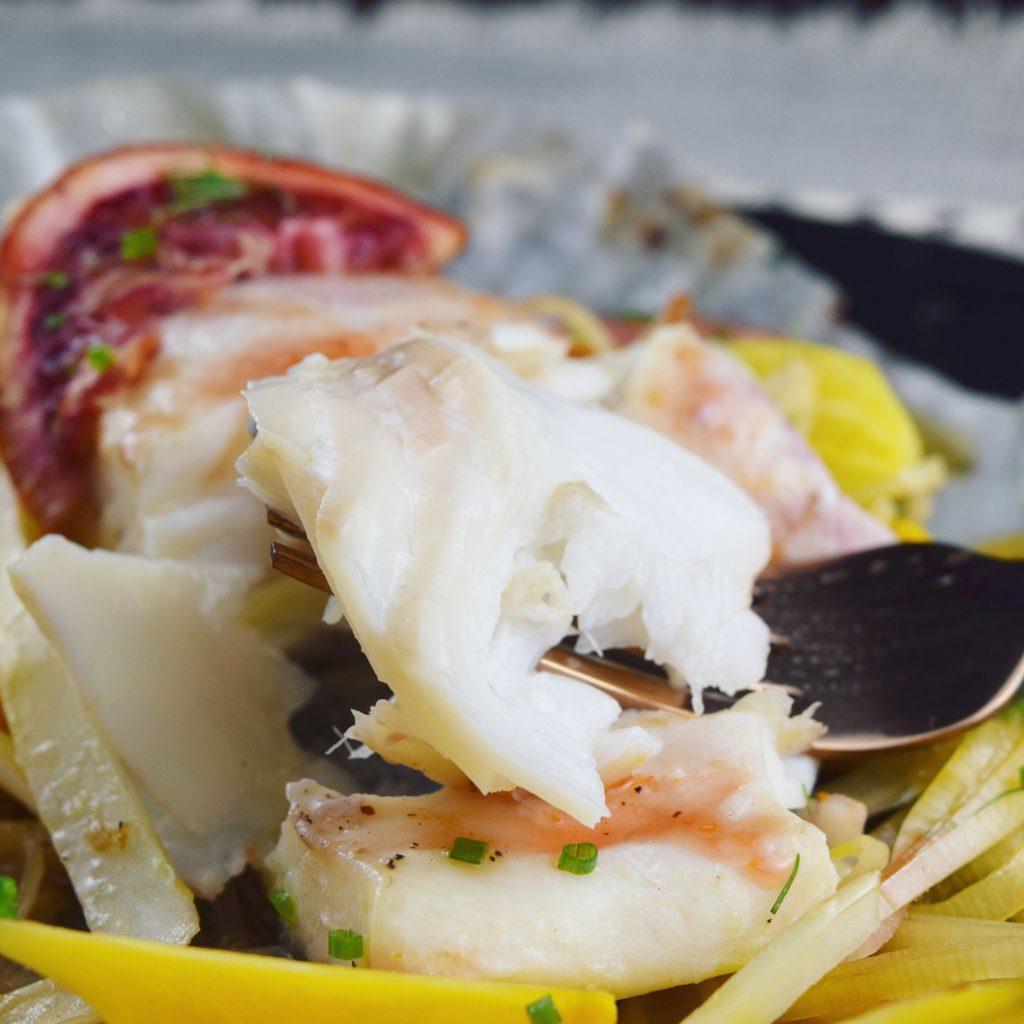
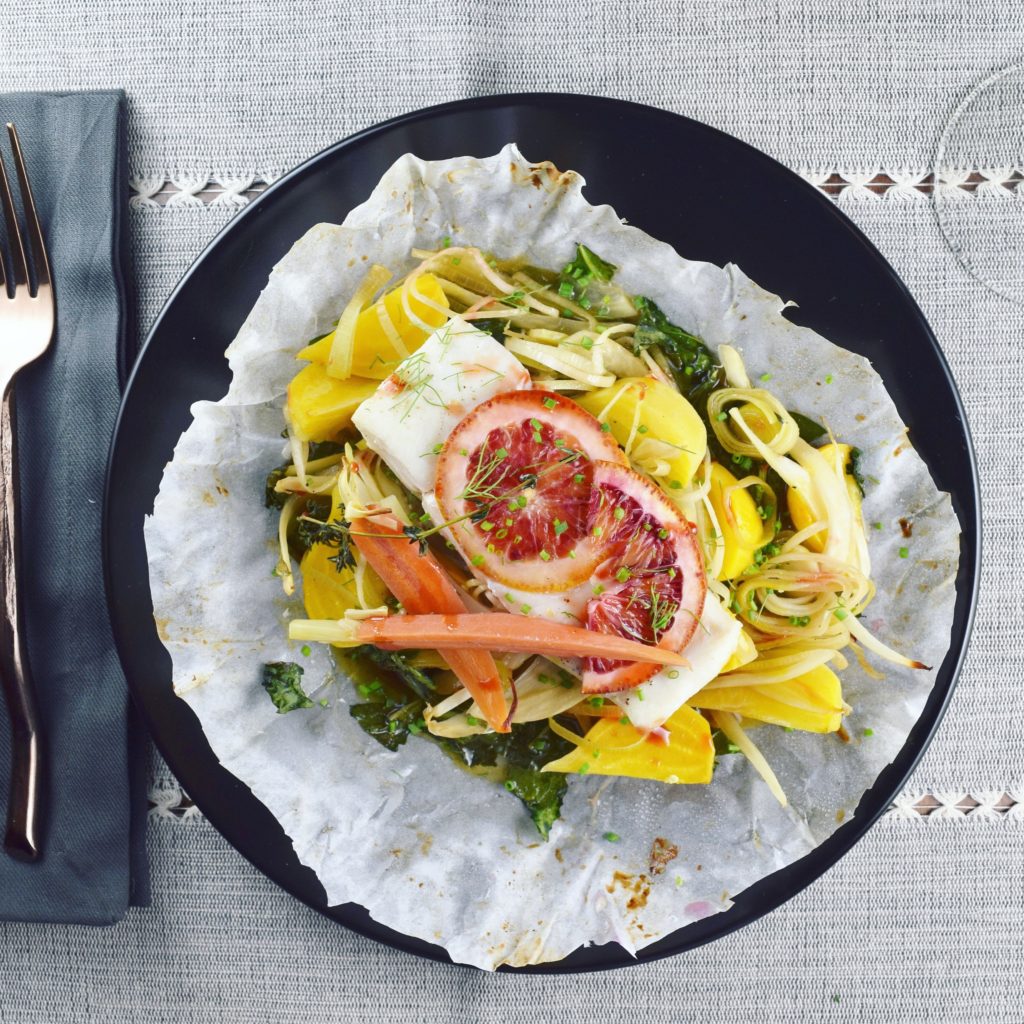
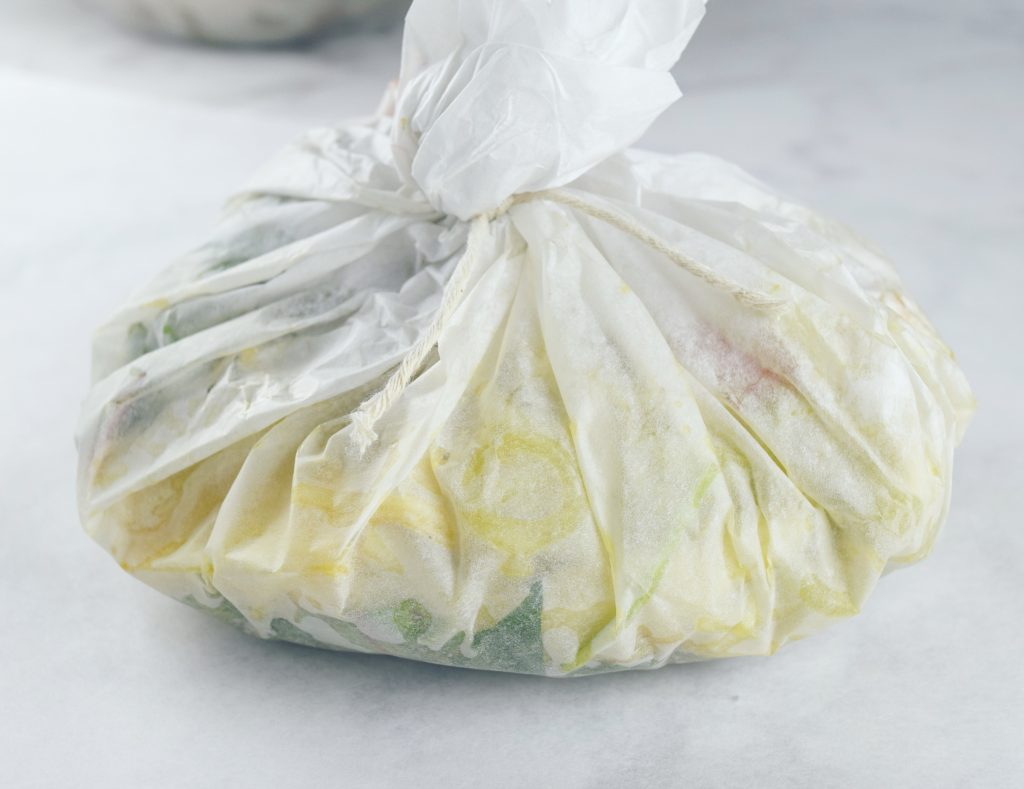
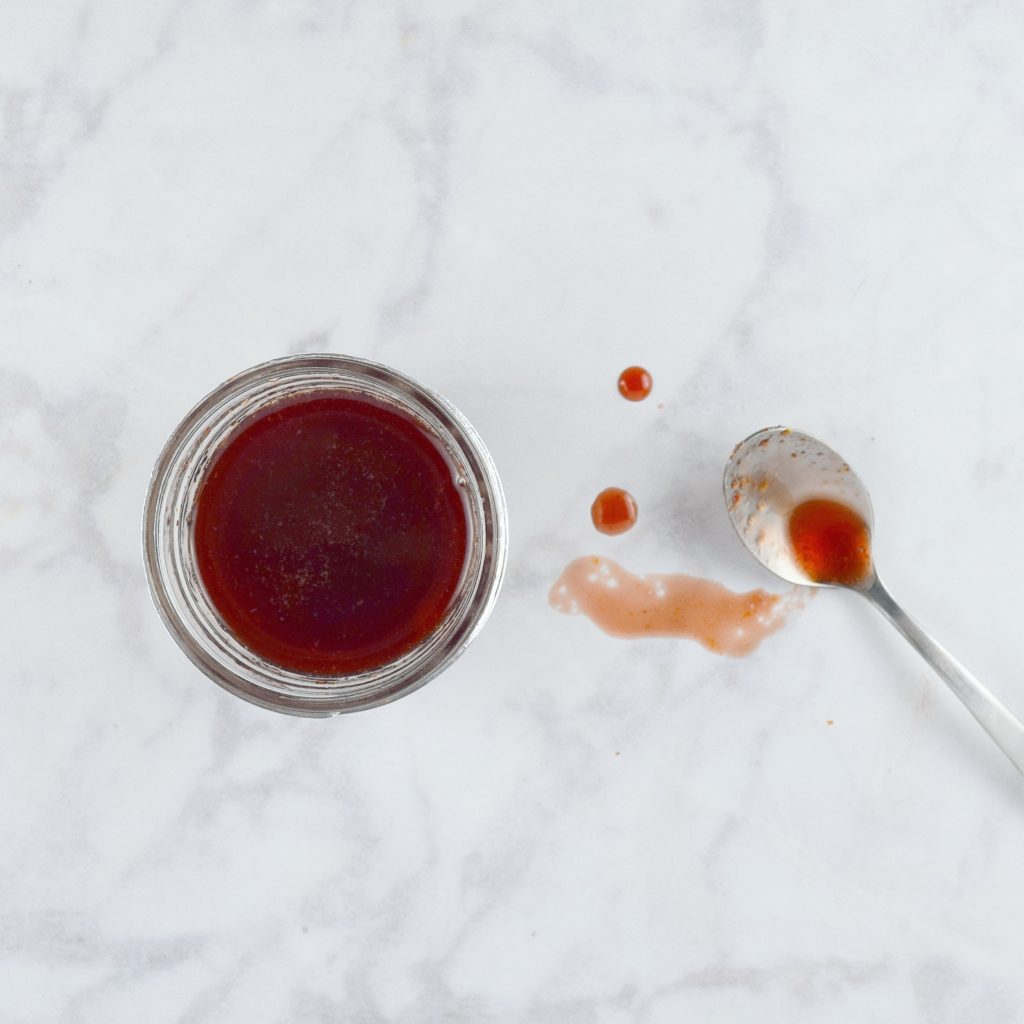
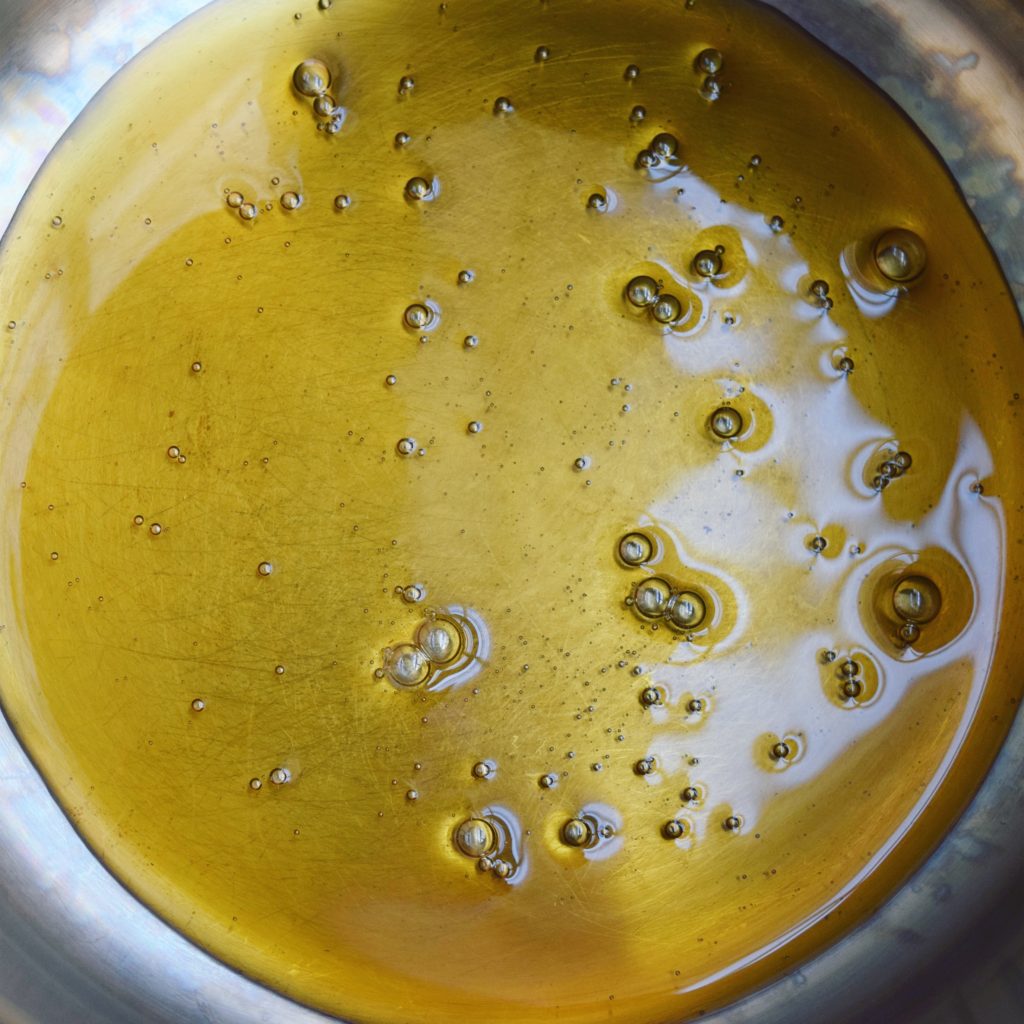

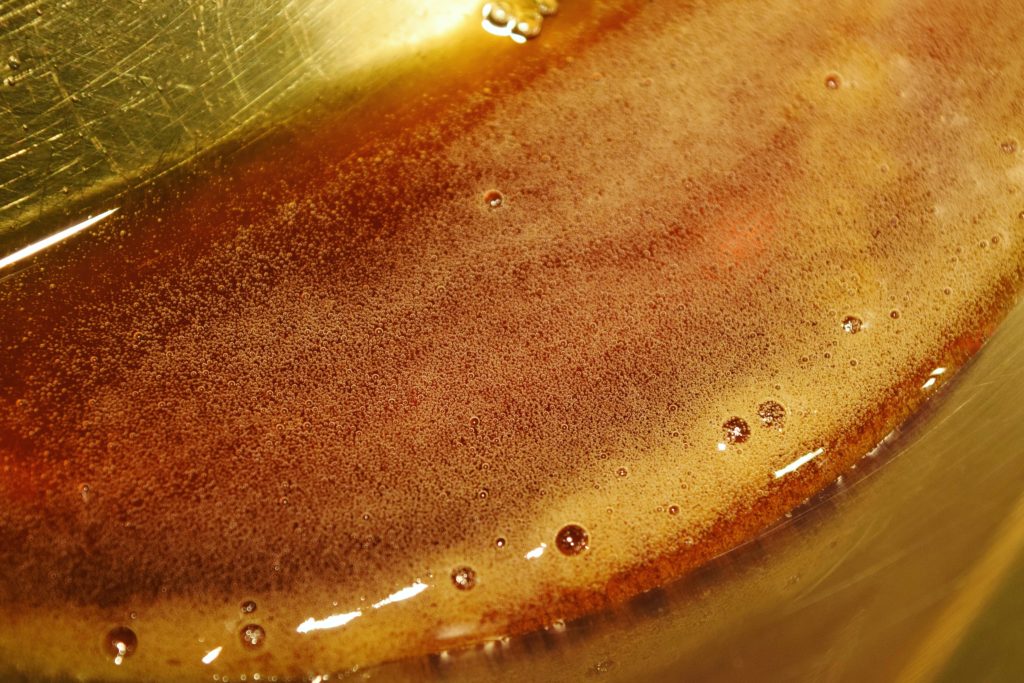
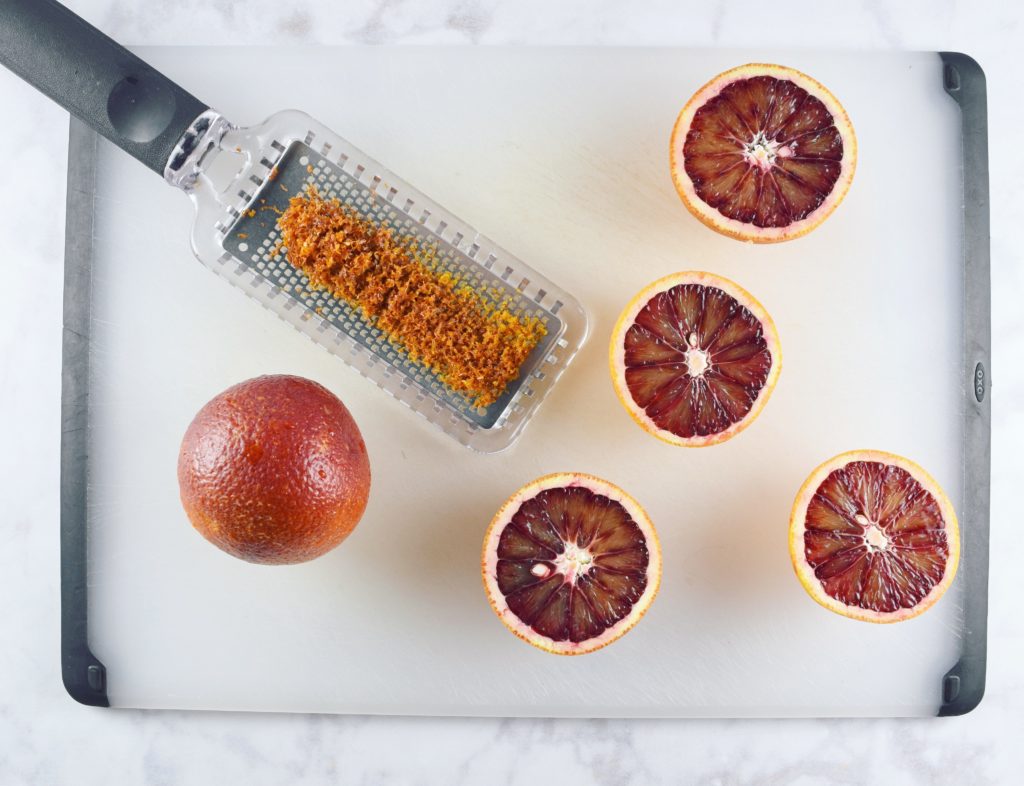
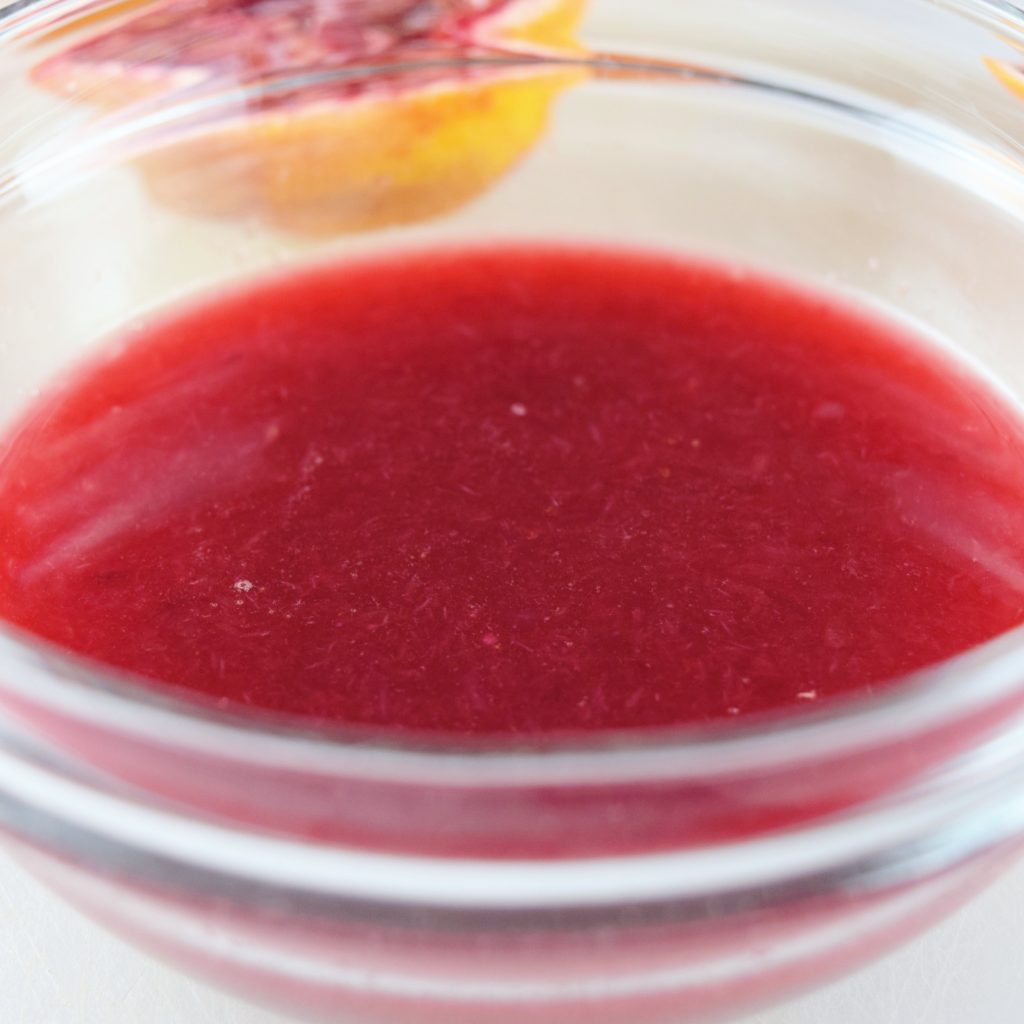
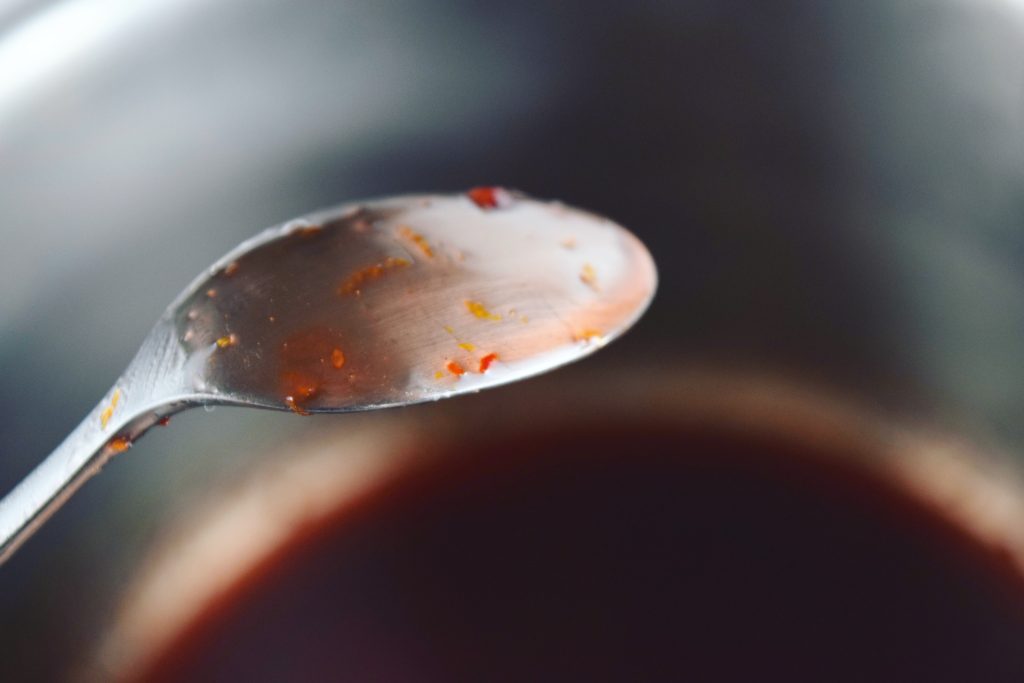
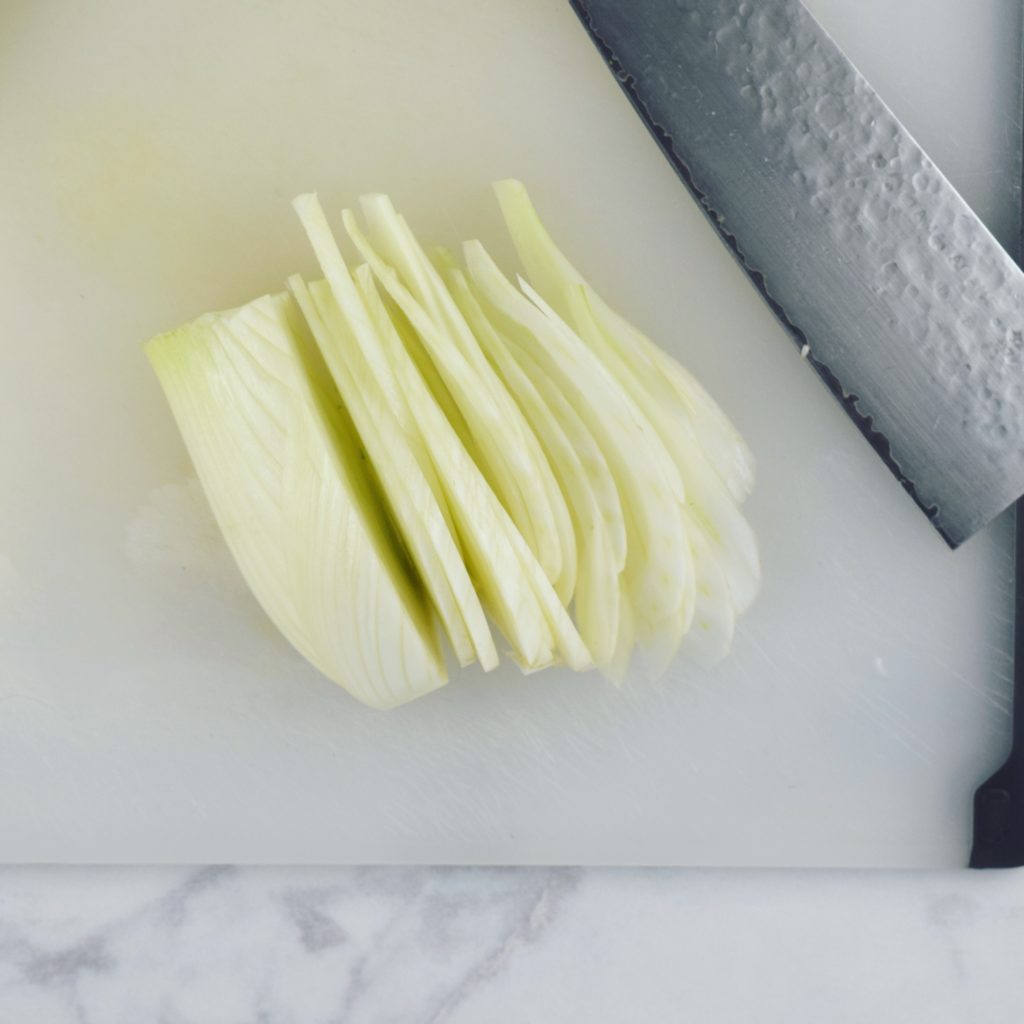
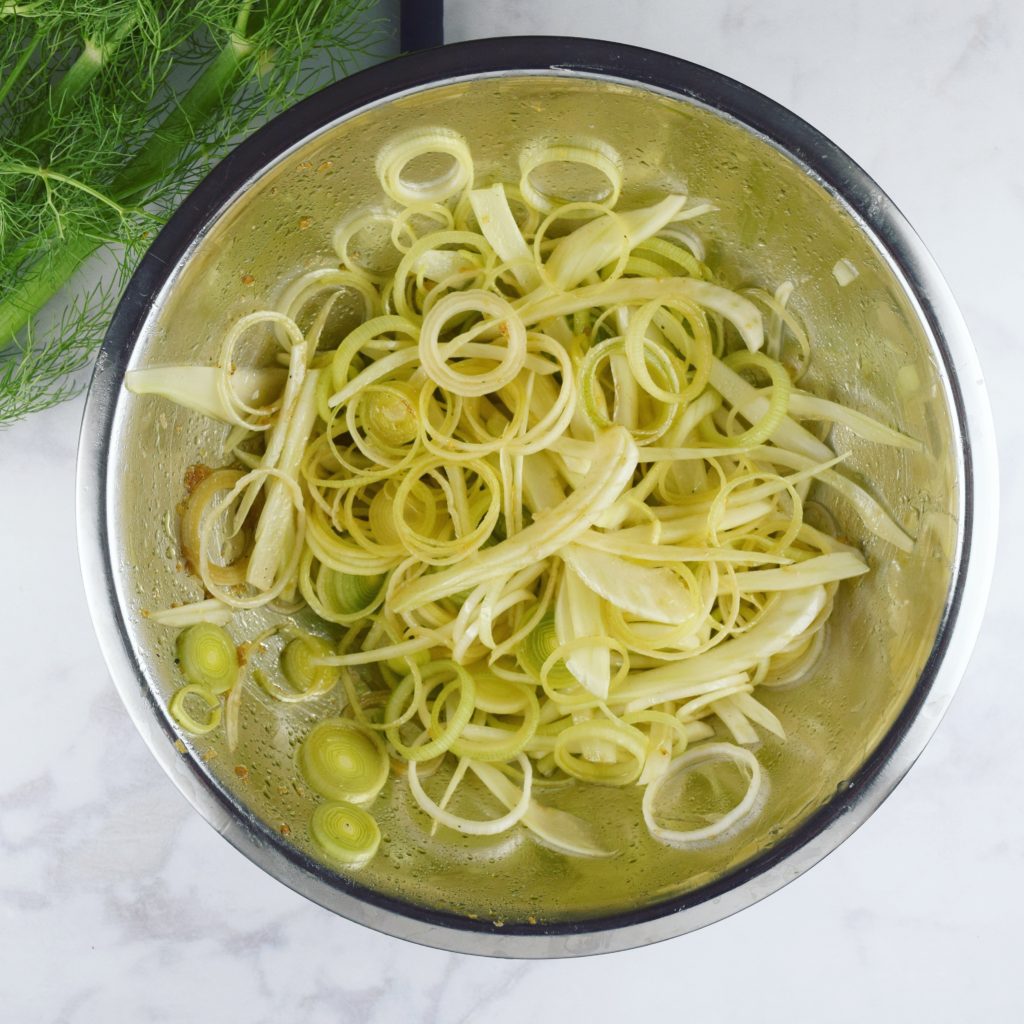
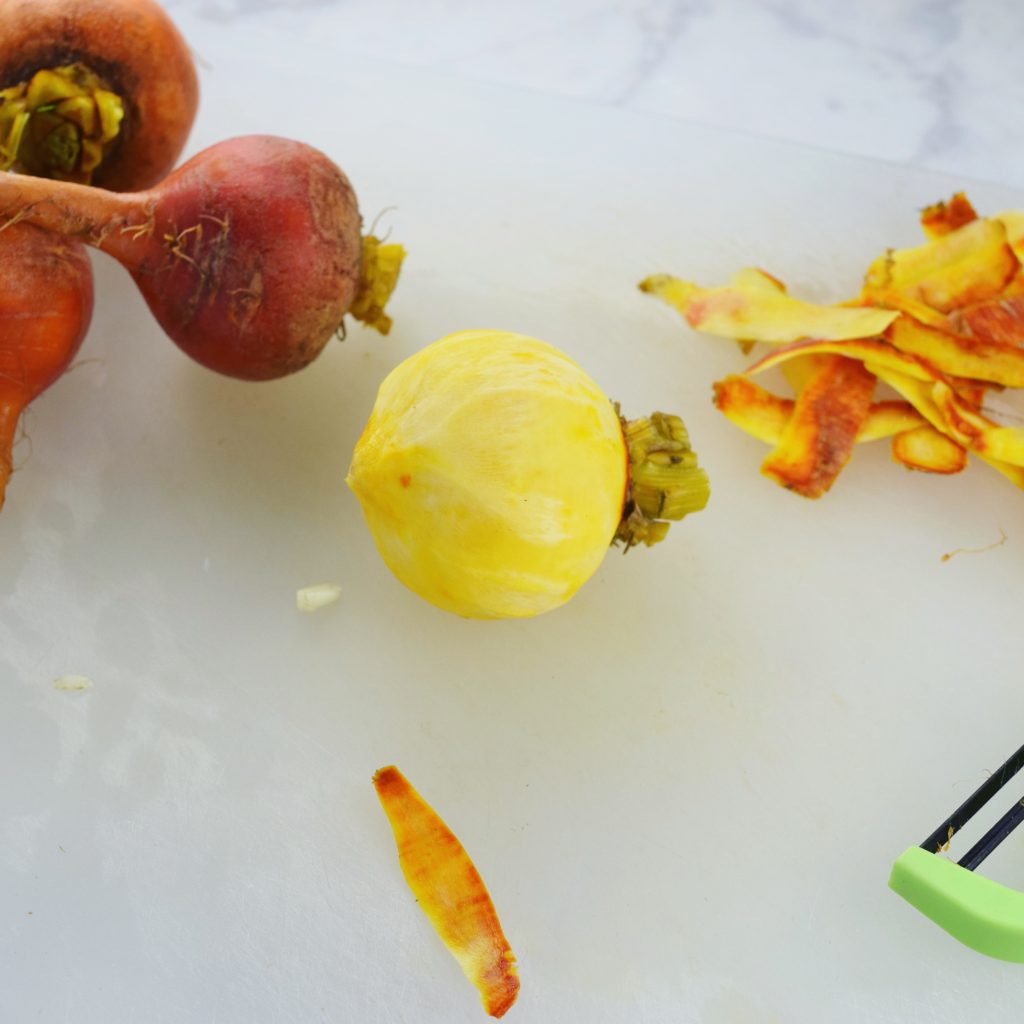
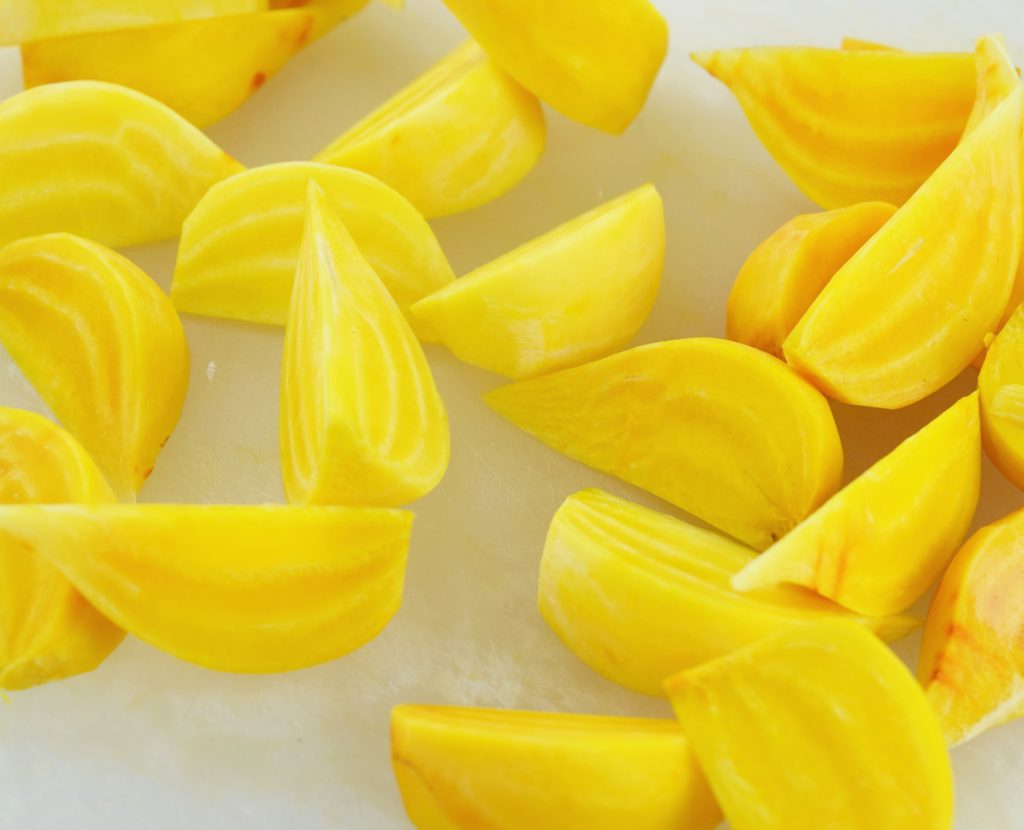
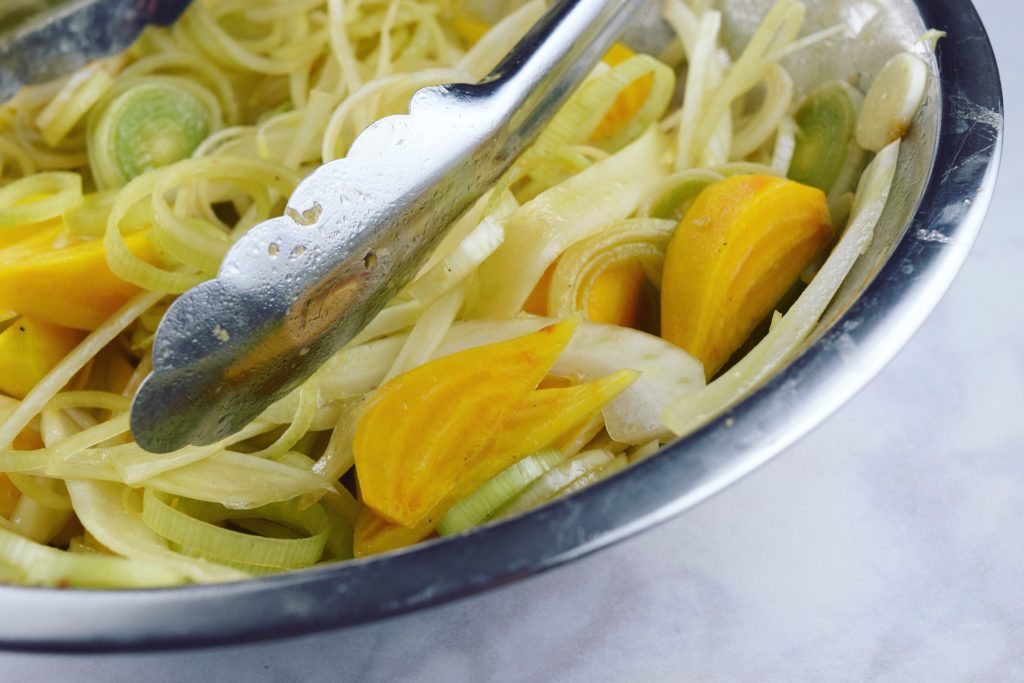
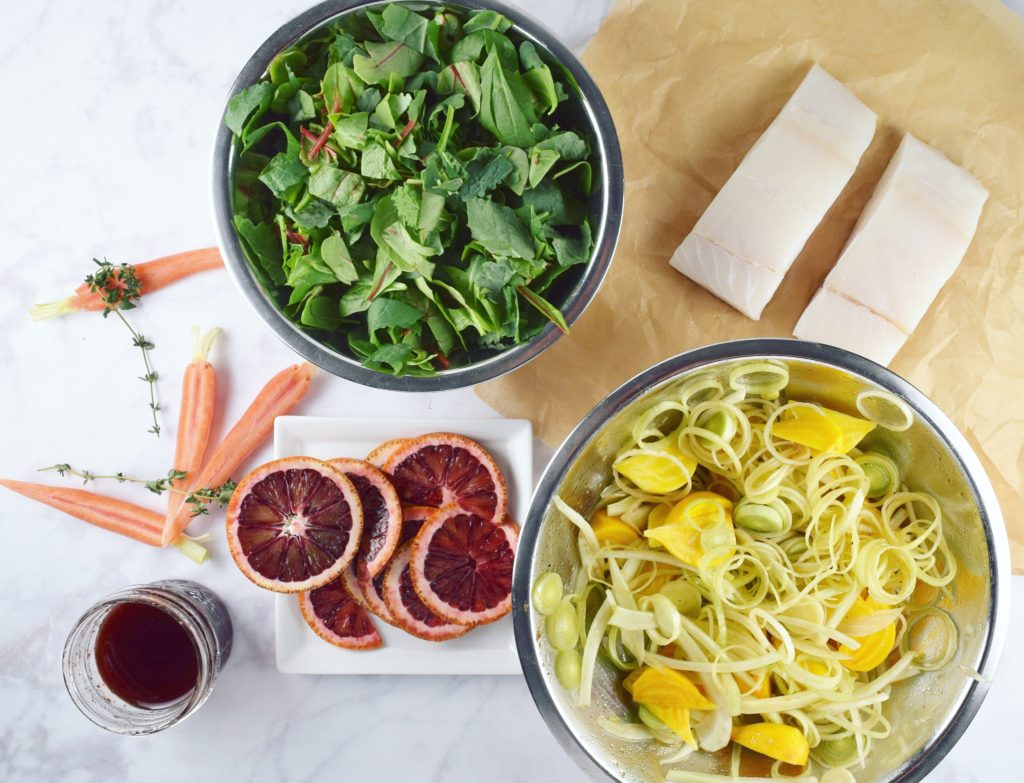
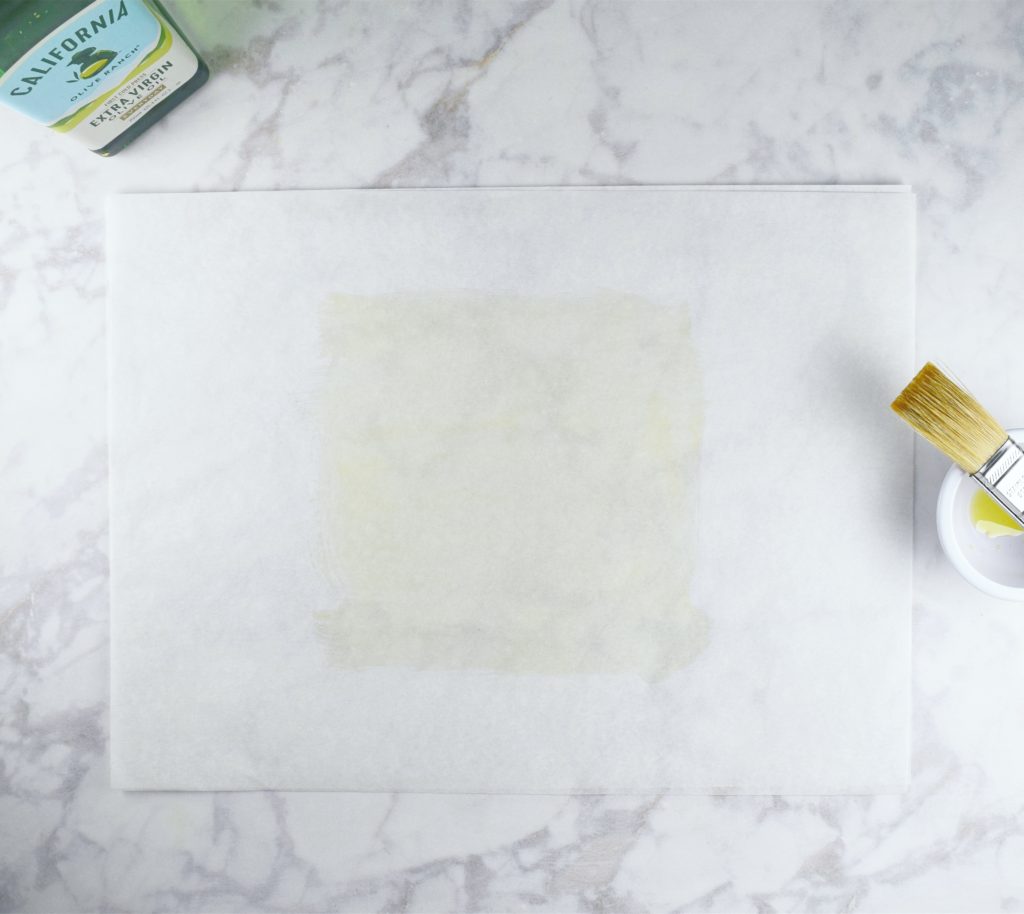
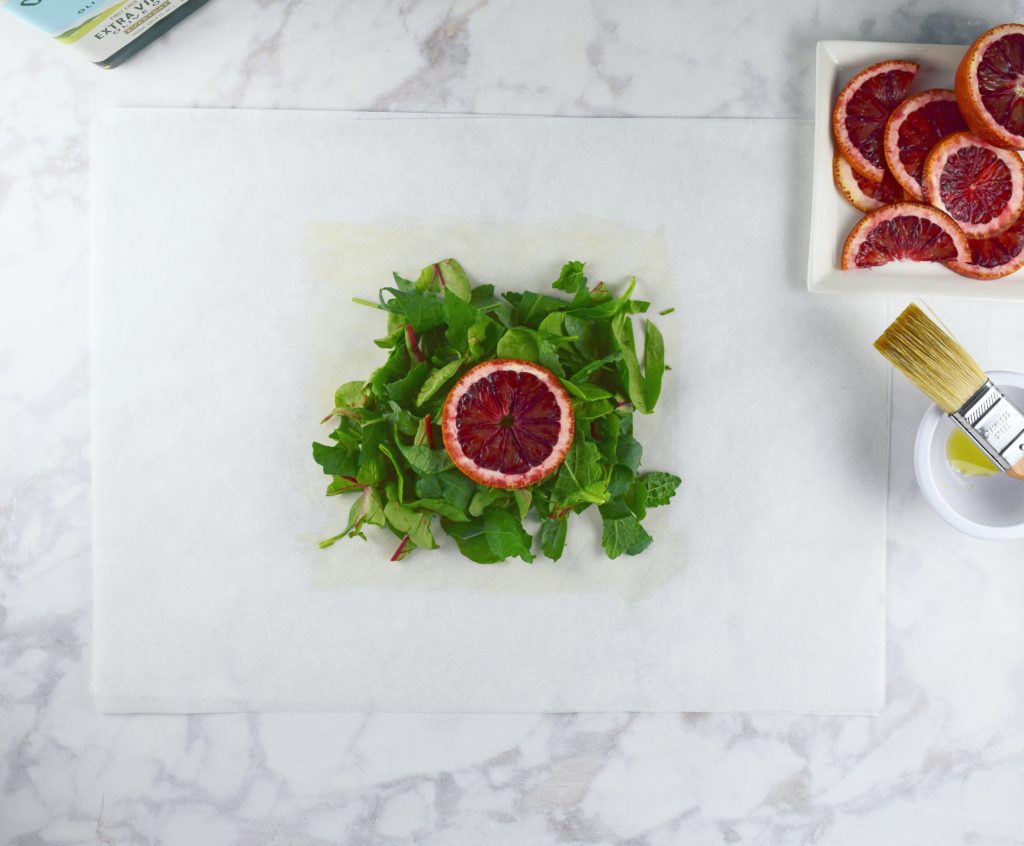
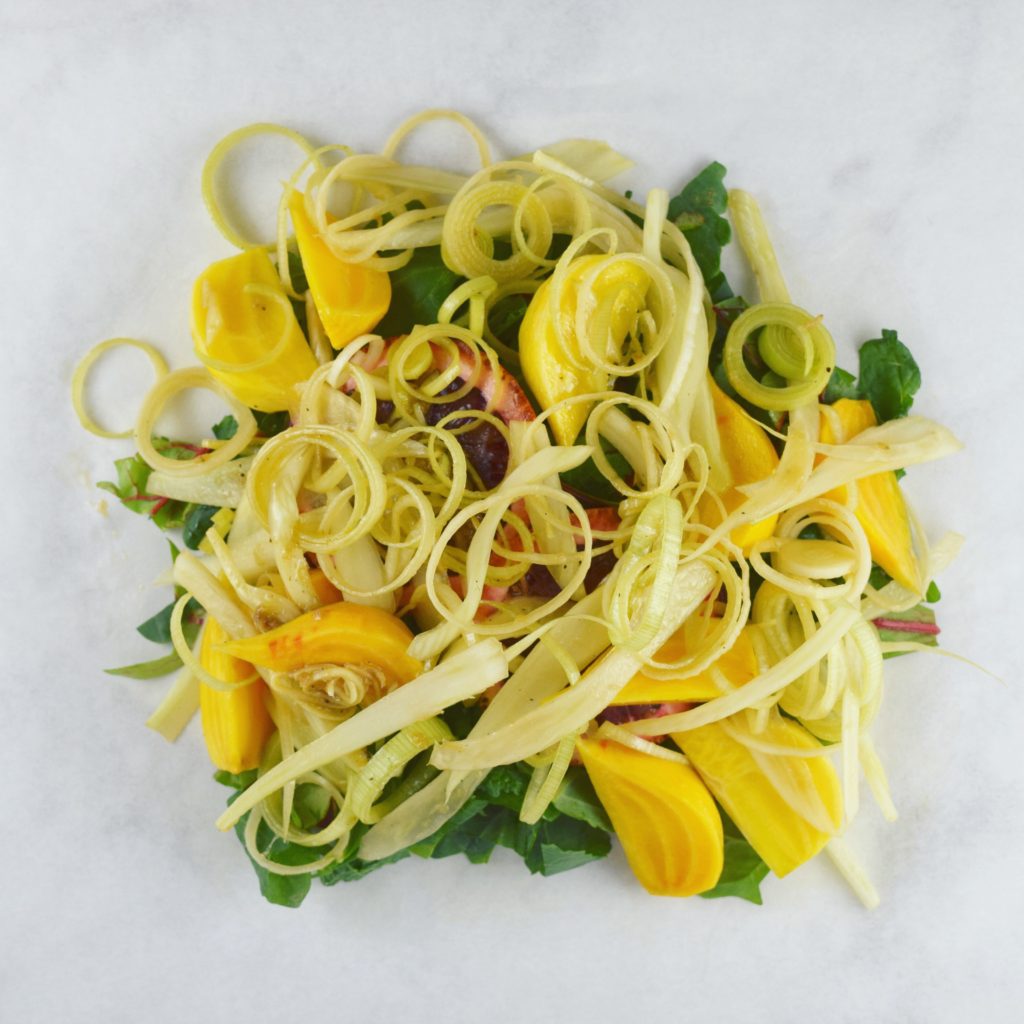
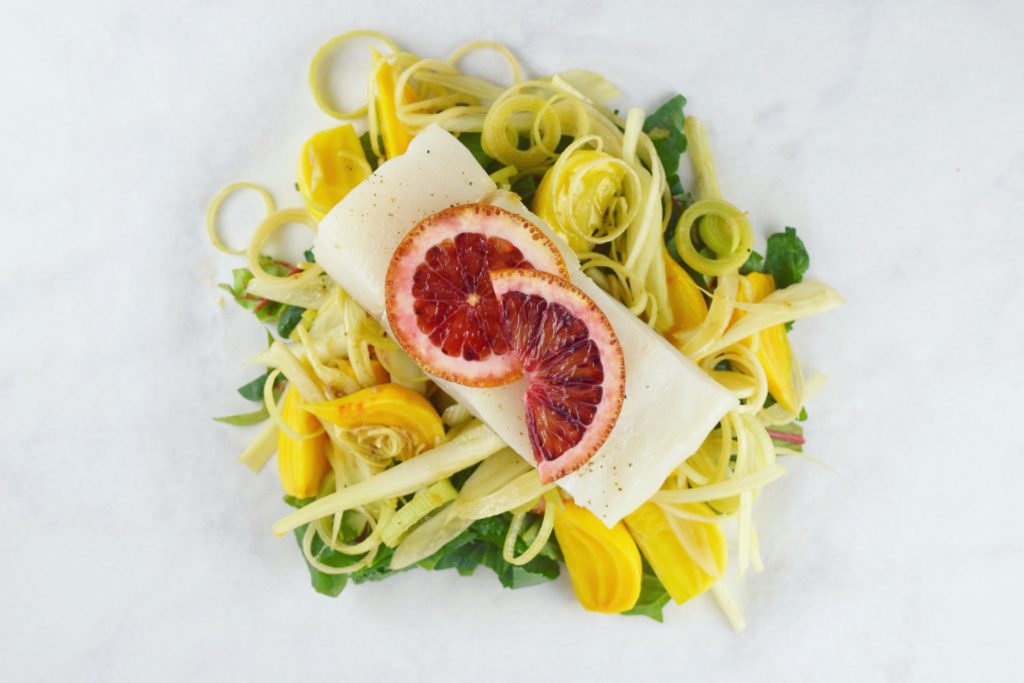
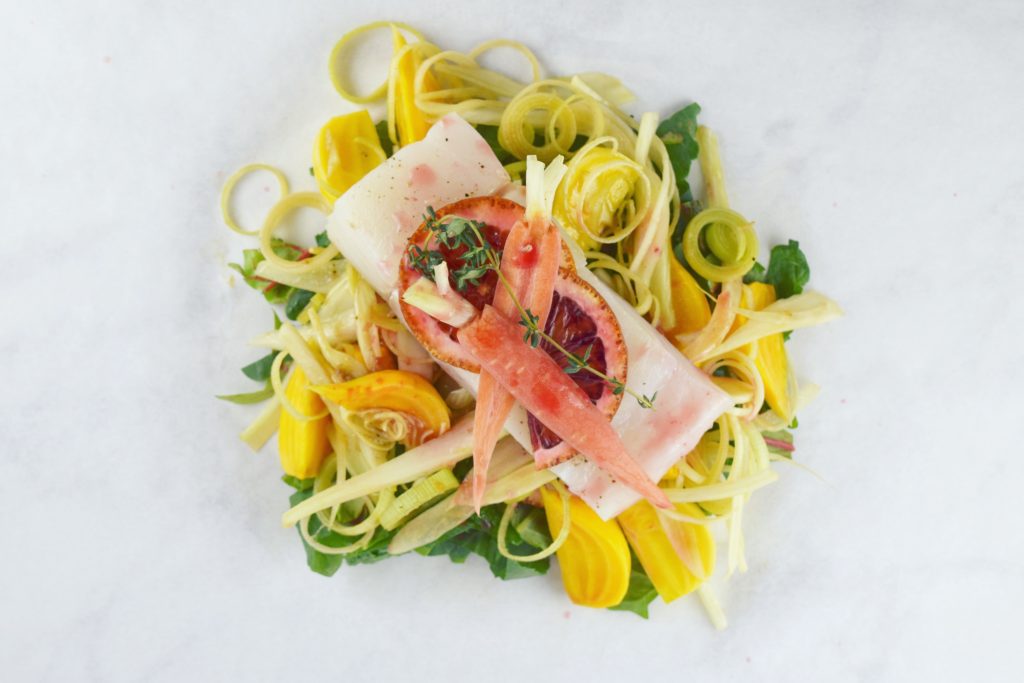
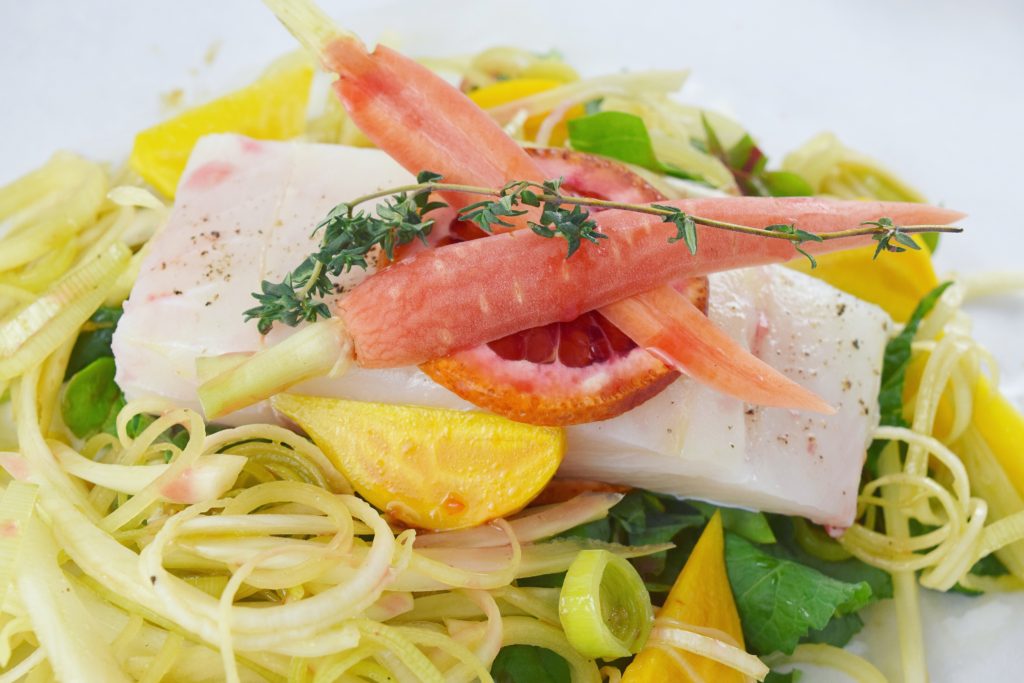
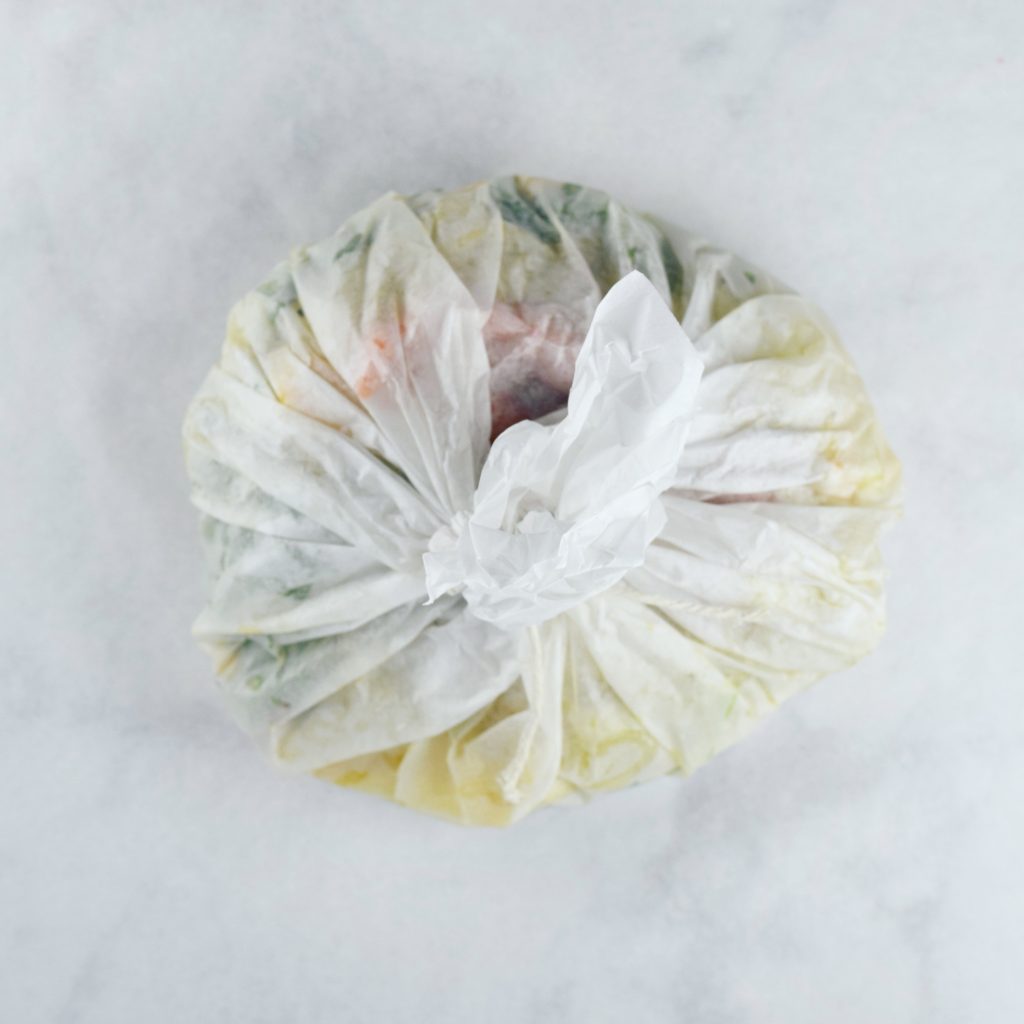
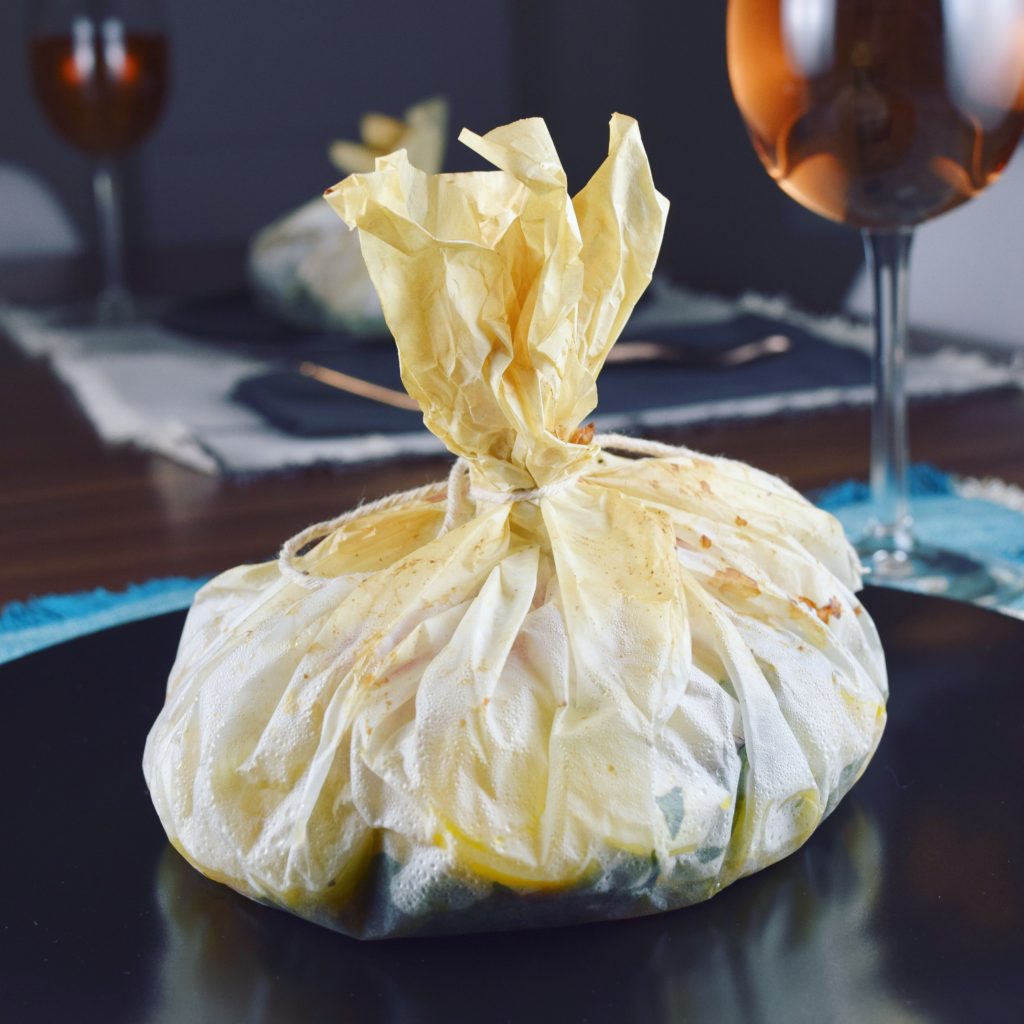
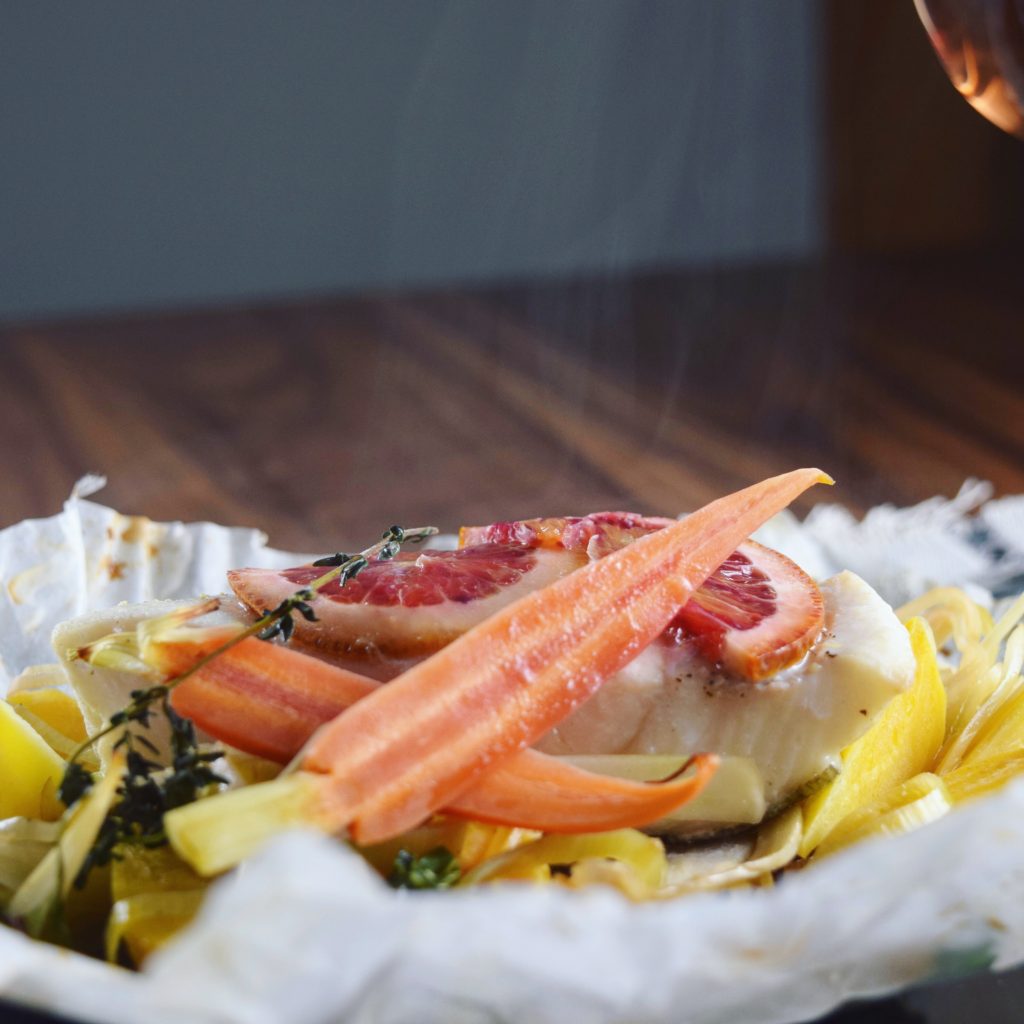
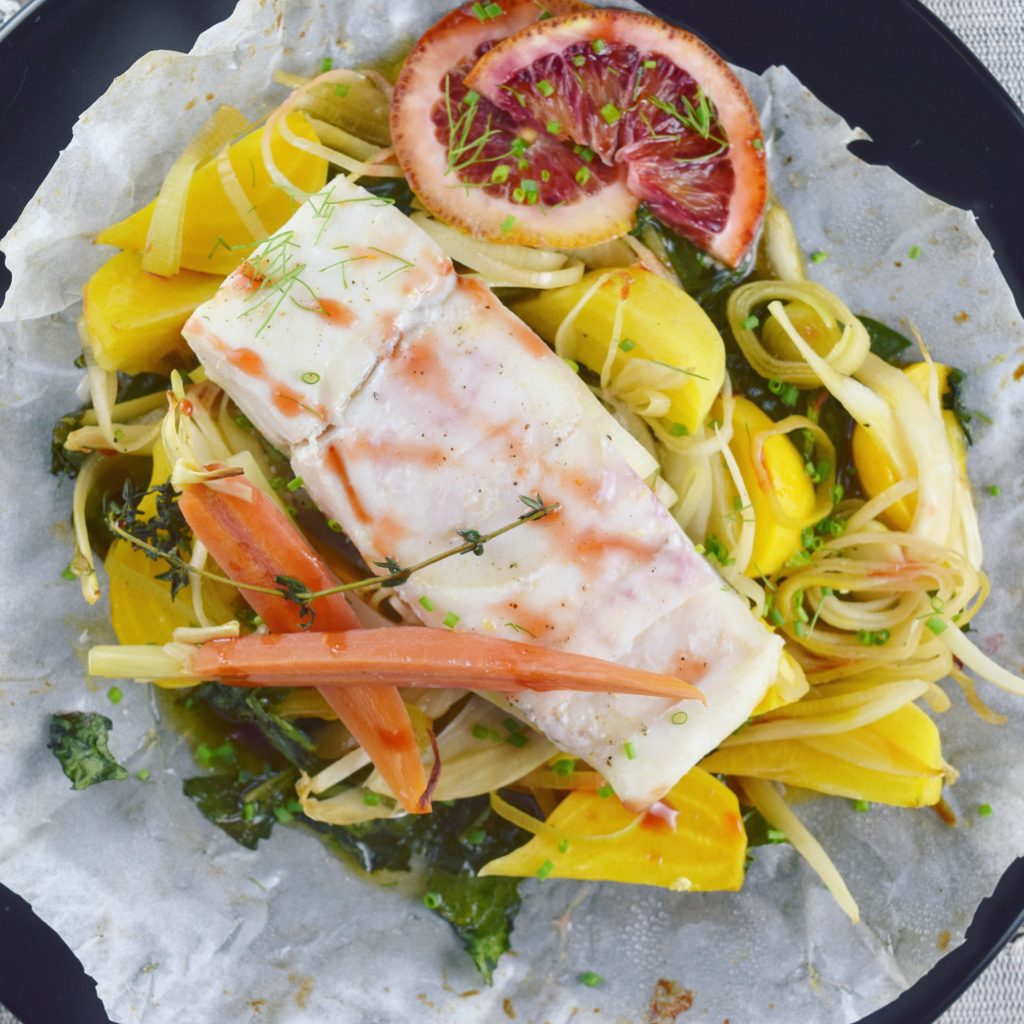
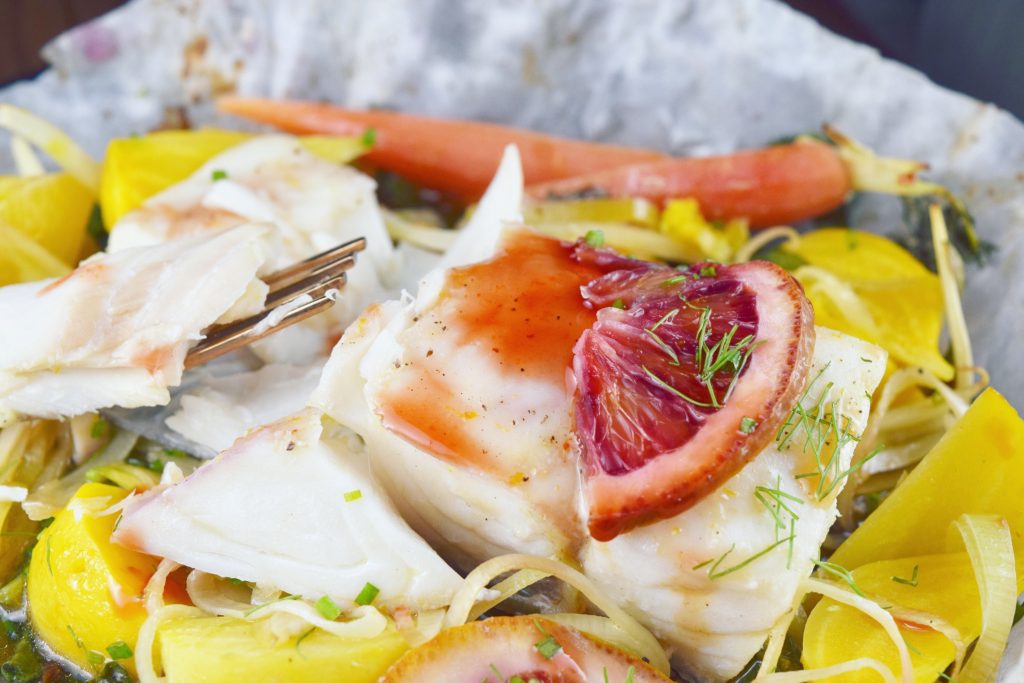
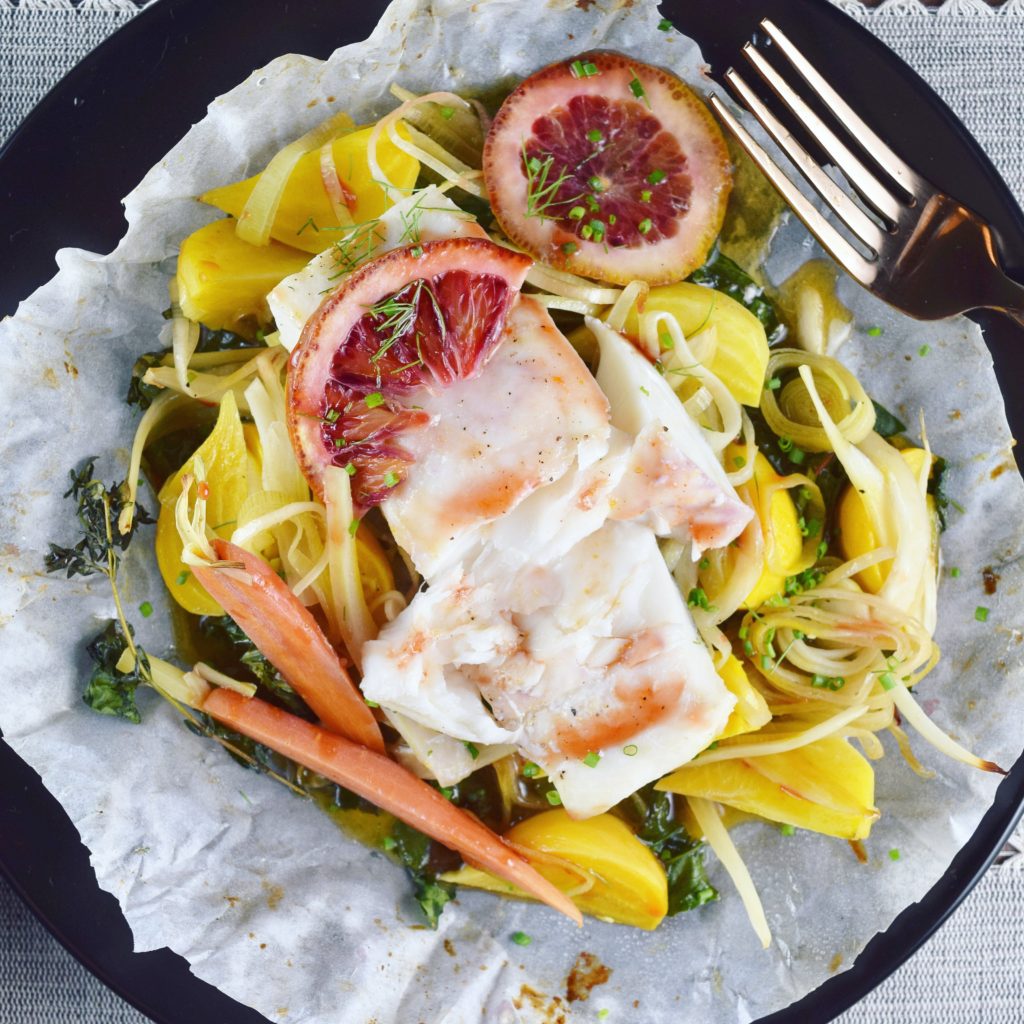


Leave a Reply